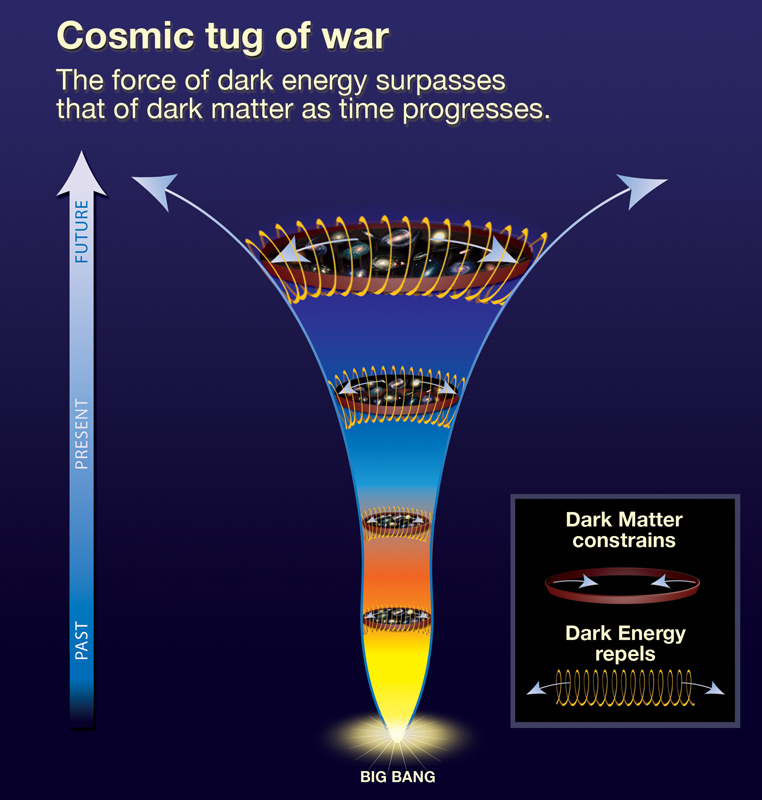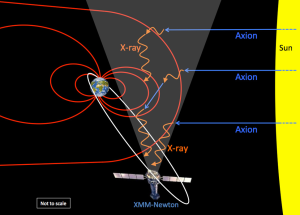Dark Energy Insights: Understanding the Universe’s Future
Dark energy, a term used to describe the enigmatic force driving the accelerating expansion of the universe, continues to pique the interest of astrophysicists globally. Recent findings from the Dark Energy Spectroscopic Instrument (DESI) collaboration, which includes renowned researchers from Harvard, suggest that this cosmic phenomenon—often equated with the cosmological constant—might be losing its strength over time. Such revelations could challenge long-standing theories about the universe’s behavior and prompt scientists to reassess their understanding of cosmic evolution. With the expansion of the universe at the forefront of modern astrophysical research, dark energy analysis has become essential to deciphering the fate of the cosmos. The implications of these discoveries are profound, as they hold the key to understanding not just the universe’s history but also its ultimate destiny.
In the realm of cosmology, the exploration of dark energy has become a focal point for understanding the universe’s intricate mechanisms. Often described in terms of an anti-gravity force, dark energy represents a significant contributor to the overall dynamics of cosmic expansion. Researchers are delving into alternative theories surrounding this elusive energy, including its characterization as a cosmological constant, as they seek to unravel the mysteries of the universe’s accelerating growth. The collaborative efforts of international teams, particularly through initiatives like the DESI project, underscore the importance of astronomy in elucidating cosmic phenomena. As scientists analyze data collected over billions of years, they aim to map the unseen influences shaping our universe and address the pressing questions regarding its future.
Understanding Dark Energy: A Key to the Universe’s Expansion
Dark energy has become a central focus in contemporary astrophysics, particularly as it pertains to the universe’s rapid expansion. Initially introduced as the ‘cosmological constant’ by Albert Einstein, dark energy is currently thought to account for approximately 68% of the universe’s total energy content. Recent findings from the Dark Energy Spectroscopic Instrument (DESI) collaboration indicate that this enigmatic force may not be constant after all, leading researchers to delve deeper into its behavior over time. This revelation not only challenges existing theories but opens the door for new models that could redefine our understanding of cosmic dynamics.
The implications of a changing dark energy landscape are vast. If this force is weakening, as suggested by the latest DESI analysis, it may alter predictions about the future trajectory of the universe, potentially leading to scenarios that have yet to be imagined. By examining the intricate dance between dark energy and matter, scientists aim to uncover the underlying principles that dictate cosmic expansion. Such insights are crucial, as they affect everything from galaxy formation to the ultimate fate of the cosmos.
The Role of the Cosmological Constant in Current Astrophysical Theories
The cosmological constant has been a key term in cosmological studies as researchers seek to understand the forces implied by dark energy. It offers a theoretical foundation for examining how dark energy influences the expansion of the universe. Within this framework, the cosmological constant is expressed mathematically, reflecting the energy density of empty space. This theoretical construct has been crucial in developing models that describe various phenomena, from the rate of expansion to the formation of cosmic structures.
However, recent observations derived from DESI’s extensive survey of the universe challenge the long-held belief that the cosmological constant remains constant. As scientists gather more data from millions of galaxies, they must reevaluate the implications of a variable cosmological constant in predicting cosmic evolution. This reexamination is pivotal, as it may lead to groundbreaking advancements in our comprehension of the universe’s history and future.
The DESI Collaboration: A Global Effort to Map Dark Energy
The Dark Energy Spectroscopic Instrument (DESI) represents a collaborative effort involving over 900 researchers across more than 70 institutions worldwide. This global initiative is primarily aimed at exploring dark energy’s effects through a comprehensive survey of the cosmos. By utilizing state-of-the-art technology to observe the expansion of the universe, the DESI collaboration has rapidly become an essential player in the field of cosmology. With a dataset that spans millions of celestial objects, researchers are now better equipped to analyze patterns of galaxy distribution and their intricate relationship with dark energy.
As the project continues to unfold, DESI’s significance grows, particularly regarding its implications for understanding the universe’s fate. Through detailed analysis and collaboration, researchers are harnessing the power of collective knowledge to address pressing questions related to dark energy’s role in cosmic expansion. The collaborative spirit of DESI not only fosters innovation but also strengthens the astrophysics community’s resolve to unravel the mysteries of our universe.
Baryon Acoustic Oscillations: A Historical Perspective on Dark Energy
Baryon Acoustic Oscillations (BAOs) provide a crucial historical lens through which scientists can examine the effects of dark energy on the universe’s evolution. These oscillations represent sound waves from the early universe, which left behind a characteristic imprint in the distribution of galaxies. By measuring the scale of these imprints, researchers leverage them as cosmic rulers to gauge the expansion history of the universe. This method not only offers insights into dark energy’s behavior over billions of years but also highlights how initial conditions shape the current cosmic landscape.
The analysis of BAOs has evolved significantly with the advancement of tools like DESI, which allows for the construction of extensive 3D maps of the universe. These maps enable scientists to track changes in galaxy distributions and to quantify the fluctuations of dark energy. As new data emerges, the understanding of BAOs continues to refine our grasp of cosmic expansion, illustrating the profound interconnectedness of dark energy and the universe’s overall structure.
Data Release 1: Unlocking a Treasure Trove for Astrophysics Research
The recent announcement from the DESI collaboration regarding Data Release 1 marks a pivotal moment for astrophysical research. This extensive dataset provides unprecedented access to information concerning over 14 million celestial objects, opening new avenues for inquiry into the universe’s structure and evolution. Researchers across disciplines can now delve into a treasure trove of astrophysical metrics that will support studies ranging from dark energy analysis to galaxy formation processes, significantly enriching the scientific landscape.
Access to such a vast dataset empowers researchers to refine existing theories and propose innovative models. With the availability of rich data on dark energy and its interactions, scientists can test hypotheses regarding cosmic expansion more rigorously. This initiative exemplifies the collaborative approach of the DESI project, further enabling scholars worldwide to engage in groundbreaking research that may reshape our understanding of the universe.
Examining Galaxy Evolution Through the Lens of Dark Energy
Galaxy evolution is intricately linked to the behavior of dark energy, making it a vital area of study for astrophysicists. As dark energy drives the expansion of the universe, it shapes the formation and evolution of galaxies. By analyzing cosmic structures and their relationships with dark energy dynamics, scientists can gain valuable insights into how galaxies develop and interact over time. The findings from DESI demonstrate that the impact of dark energy is not just a modern phenomenon but has been influencing galaxy evolution throughout the universe’s history.
Furthermore, the collaboration among international researchers facilitates a more comprehensive understanding of galaxy formation. By incorporating various cosmic surveys, DESI allows scientists to explore the complex web of relationships between dark energy, galaxy attributes, and cosmic structures. This holistic approach provides a unique framework for predicting future galaxy behavior and for investigating the underlying reasons for observed cosmic diversity.
The Cosmic Web: How Dark Energy Influences Galactic Structures
The cosmic web is a large-scale structure that reveals the intricate distribution of galaxies and dark matter across the universe. Dark energy plays a crucial role in shaping this web, influencing how galaxies cluster and interact. The expansion driven by dark energy has a profound impact on the dynamic nature of the cosmic web. By studying these interactions, astronomers seek to understand how dark energy affects the evolution of galactic structures and their properties over time.
With the data gathered from the DESI collaboration, scientists can now map the cosmic web with unparalleled detail. This level of analysis enables researchers to discern patterns and connections that were previously obscured. Utilizing advanced simulations, they can predict how variations in dark energy affect the formation of structures within the cosmic web, helping to elucidate the underlying physics of the universe.
Future Predictions: Dark Energy’s Role in the Universe’s Fate
As research progresses, the role of dark energy in the ultimate fate of the universe remains a critical area of inquiry. With ongoing analysis from the DESI collaboration, scientists are gaining insights into how dark energy may evolve and influence cosmic expansion in the coming epochs. If current trends suggest a weakening dark energy, models predicting the long-term dynamics of the universe will need substantial reevaluation. This critical examination may lead to new theories about the ultimate fate of the universe, whether it be an endless expansion or a dramatic cosmic collapse.
The potential changes in dark energy offer both challenges and opportunities for astrophysics. As researchers compute future projections, they must consider varying scenarios shaped by dark energy’s influence. The collaborative nature of projects like DESI aims to unveil these uncertainties, ultimately contributing to a more refined comprehension of cosmic destiny.
Frequently Asked Questions
What is dark energy and its role in the universe’s expansion?
Dark energy is a mysterious force that makes up about 68% of the universe and is believed to be responsible for its accelerated expansion. It acts against the force of gravity, driving galaxies apart at an increasing rate. This phenomenon was first observed in 1998 when scientists noted that distant supernovae were fainter than expected, suggesting that the universe is not only expanding but doing so at an accelerating rate due to dark energy.
How does the cosmological constant relate to dark energy?
The cosmological constant is a key concept in cosmology that represents a form of dark energy. It is associated with the energy density of empty space, contributing to the acceleration of the universe’s expansion. Einstein originally introduced the cosmological constant in his equations of general relativity to allow for a static universe, but it later gained significance as a plausible explanation for dark energy.
What recent findings have emerged from the dark energy analysis by the DESI collaboration?
Recent findings from the Dark Energy Spectroscopic Instrument (DESI) collaboration suggest that dark energy might be weakening over time. This groundbreaking result has implications for our understanding of the universe and may require updates to the standard model of cosmology. Researchers used data from over 14 million galaxies to analyze the influence of dark energy and track its effects over the past 11 billion years.
How does dark energy impact the future of the universe?
The impact of dark energy on the future of the universe is profound. It is believed to dictate how cosmic structures evolve and may ultimately determine the fate of the universe—whether it continues to expand forever, reaches a steady state, or recollapses. As current research, including findings from the DESI collaboration, indicates that dark energy may be changing, this could shift our predictions about the universe’s ultimate fate.
What technologies and methods does the DESI collaboration use in dark energy research?
The DESI collaboration employs advanced telescope technologies and algorithms to create the largest 3D map of the universe. By analyzing the distribution of galaxies and quasars, researchers can assess the effects of dark energy and Baryon Acoustic Oscillations, which serve as an essential standard ruler for measuring cosmic distances. This method allows them to gather precise data crucial for understanding dark energy’s role throughout the history of the universe.
What is the significance of Baryon Acoustic Oscillations (BAOs) in dark energy studies?
Baryon Acoustic Oscillations are oscillations in the density of visible baryonic matter (normal matter) that were imprinted in the universe’s structure shortly after the Big Bang. They serve as a ‘standard ruler’ for cosmological distance measurements and are pivotal in dark energy studies. By analyzing the size and distribution of these oscillations, scientists can gain insights into the strength of dark energy over time, helping to refine our understanding of the universe’s expansion.
How can the public access the data released by the DESI collaboration?
The DESI collaboration has made its Data Release 1 publicly available, which allows anyone interested in astrophysical research to explore extensive data on millions of celestial objects. This dataset can be accessed through online platforms like the arXiv repository, and it provides valuable resources for researchers studying dark energy, galaxy evolution, and other cosmological phenomena.
What role do researchers from Harvard play in dark energy analysis?
Researchers from Harvard, particularly those from the Center for Astrophysics, play a vital role in the analysis of dark energy through the DESI collaboration. They contribute by developing algorithms, simulations, and interpreting data that aid in our understanding of dark energy’s influence on the universe. Notably, prominent faculty members have co-directed important projects, highlighting Harvard’s significant involvement in advancing dark energy research.
| Key Point | Details |
|---|---|
| Collaboration | The Dark Energy Spectroscopic Instrument (DESI) involves over 900 researchers from more than 70 institutions globally. |
| Research Focus | The study focuses on dark energy, believed to cause the universe’s accelerating expansion. |
| Findings | Recent data suggests dark energy may be weakening, indicating a potential update to the standard cosmological model. |
| Methodology | Analysis is based on the largest 3D map of the universe, studying the distribution of matter over 11 billion years. |
| Contribution of CfA | Center for Astrophysics played a key role in data analysis and algorithm development for DESI. |
| Educational Outreach | DESI also collaborates on educational projects to engage the public with dark energy research. |
Summary
Dark energy is a fundamental aspect of cosmology, crucial to understanding the universe’s expansion and ultimate fate. Recent research from the Dark Energy Spectroscopic Instrument (DESI) collaboration indicates that the nature of dark energy may be changing, which could necessitate revisions to existing models of cosmic behavior. With ongoing analysis and data collection, researchers hope to uncover deeper insights into how dark energy influences the universe and our understanding of cosmic evolution.



